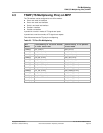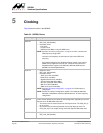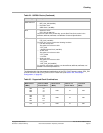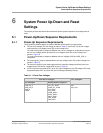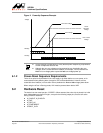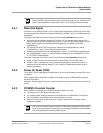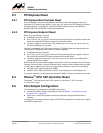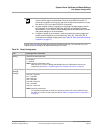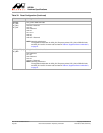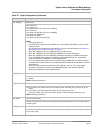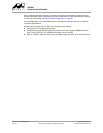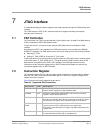
88F6281
Hardware Specifications
Doc. No. MV-S104859-U0 Rev. E Copyright © 2008 Marvell
Page 66 Document Classification: Proprietary Information December 2, 2008, Preliminary
6.3 PCI Express Reset
6.3.1 PCI Express Root Complex Reset
As a Root Complex, the device may generate a Hot Reset to the PCI Express port. Upon CPU
setting the PCI Express Control register’s <conf_mstr_hot_reset> bit, the PCI Express unit sends a
Hot Reset indication to the Endpoint, see the PCI Express Interface section in the 88F6180,
88F6190, 88F6192, and 88F6281 Functional Specifications.
6.3.2 PCI Express Endpoint Reset
When a Hot Reset packet is received:
A maskable interrupt is asserted.
If the <conf_dis_hot_rst_reg_rst> field in the PCI Express Debug Control register is cleared, the
device also resets the PCI Express register file to its default values.
The device triggers an internal reset, if not masked by the <conf_msk_hot_reset> field in the
PCI Express Debug Control register.
Link failure is detected if the PCI Express link was up (LTTSSM L0 state) and dropped back to an
inactive state (LTSSM Detect state). When Link failure is detected:
A maskable interrupt is asserted.
If the <conf_dis_link_fail_reg_rst> field in the PCI Express Debug Control register is cleared,
the device also resets the PCI Express register file to its default values.
The device triggers an internal reset, if the <conf_msk_link_fail> field is not masked by PCI
Express Debug Control register.
Both link fail and hot reset conditions trigger a chip internal reset (if not masked in the PCI Express
interface). All the chip logic is reset to the default values, except for sticky registers and the sample
on reset logic. In addition, these events can trigger reset to the board, using one of the following:
PEX_RST_OUTn signal (multiplexed on MPP).
SYSRST_OUTn output (multiplexed on MPP)—if not masked by the <PexRstOutEn> bit.
The external reset logic (on the board) may assert the SYSRSTn input pin and reset the entire chip.
6.4 Sheeva
™
CPU TAP Controller Reset
The Sheeva
™
CPU Test Access Port (TAP) controller is reset when JT_RSTn is set and
JT_TMS_CPU is active.
6.5 Pins Sample Configuration
The following pins are sampled during SYSRSTn de-assertion:
Internal pull up/down resistors set the default mode (see Section 1.3, Internal Pull-up and
Pull-down Pins, on page 48).
Higher value, external pull up/down resistors are required to change the default mode of
operation.
These signals must remain pulled up or down until SYSRSTn de-assertion (zero hold time in respect
to SYSRSTn de-assertion).




